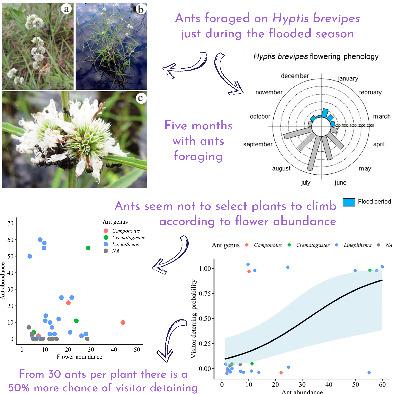当前位置:
X-MOL 学术
›
Ecol. Entomol.
›
论文详情
Our official English website, www.x-mol.net, welcomes your
feedback! (Note: you will need to create a separate account there.)
Ants climb plants because they cannot swim: ant presence on flowers during the flood season reduces the frequency of floral visitors
Ecological Entomology ( IF 2.0 ) Pub Date : 2020-07-17 , DOI: 10.1111/een.12917 Camila S. Souza 1, 2 , Gudryan J. Baronio 3 , Carlos E. Weirich 1 , Andressa F. Oliveira 4 , Bruno H. dos Santos Ferreira 1, 5 , Rafael Arruda 6 , Camila Aoki 5, 7
Ecological Entomology ( IF 2.0 ) Pub Date : 2020-07-17 , DOI: 10.1111/een.12917 Camila S. Souza 1, 2 , Gudryan J. Baronio 3 , Carlos E. Weirich 1 , Andressa F. Oliveira 4 , Bruno H. dos Santos Ferreira 1, 5 , Rafael Arruda 6 , Camila Aoki 5, 7
Affiliation

|
Seasonal changes in environments may not only affect habitat connectivity but may also affect its use by species and their interactions. Thus, during the flood season, ants are forced to develop survival strategies such as vertical plant migration. According to this, it has been hypothesized that the presence of ants may directly affect plant‐pollinator interactions. Thus, we asked the following questions: (i) Are floral visitors of Hyptis brevipes expelled due to ant presence on inflorescences during the flood period? (ii) Is the ant effect mediated by the abundance of ants foraging on inflorescences? And, (iii) Does flower abundance predict the abundance of floral visits and ants? We experimentally sampled 59 H. brevipes plants with and without ants during the flooded season, and observed no differences in flower abundance between ant treatments. The probability of detaining floral visitors on H. brevipes increased with ant abundance and exceeded 50% possible repellency, but the probability of visitor deterrence was not related to flower abundance. Furthermore, the abundance of flowers did not predict the number of ants on H. brevipes individuals or the frequency of floral visits. Consequently, ant repelling effects are pronounced when there are more ants foraging on plants. However, the ant repelling effect can be mitigated when plants flourish all year‐round and exhibit higher concentrations of flowers in the dry months. Additionally, the different sexual functions of plants may present specific responses due to the explosive pollination mechanism associated with ant effects.
中文翻译:

蚂蚁爬植物是因为它们不会游泳:洪水季节蚂蚁出现在花上减少了花客的频率
环境的季节性变化不仅可能影响栖息地的连通性,还可能影响物种的使用及其相互作用。因此,在汛期,蚂蚁被迫制定生存策略,例如植物垂直迁移。据此,有人假设蚂蚁的存在可能直接影响植物-传粉媒介的相互作用。因此,我们提出了以下问题:(i)Hyptis brevipes 的花卉访客是否因洪水期间花序上的蚂蚁而被驱逐?(ii) 蚂蚁效应是否是由大量蚂蚁在花序上觅食所介导的?并且,(iii)花的丰度是否可以预测花的访问量和蚂蚁的数量?我们在洪水季节对 59 株有和没有蚂蚁的短尾蠹植物进行了实验采样,并观察到蚂蚁处理之间的花丰度没有差异。在 H. brevipes 上滞留花卉访客的概率随着蚂蚁丰度的增加而增加并超过 50% 的可能驱避率,但阻止访客的概率与花卉丰度无关。此外,花朵的丰富程度并不能预测短尾蝽个体上蚂蚁的数量或花卉访问的频率。因此,当有更多的蚂蚁在植物上觅食时,蚂蚁的排斥效果就会很明显。然而,当植物全年蓬勃发展并在干燥月份表现出更高浓度的花朵时,可以减轻蚂蚁的排斥作用。此外,由于与蚂蚁效应相关的爆炸性授粉机制,植物的不同性功能可能会表现出特定的反应。brevipes 随着蚂蚁丰度的增加而增加并超过 50% 的可能驱虫率,但阻止访客的概率与花卉丰度无关。此外,花朵的丰富程度并不能预测短尾蝽个体上蚂蚁的数量或花卉访问的频率。因此,当有更多的蚂蚁在植物上觅食时,蚂蚁的排斥效果就会很明显。然而,当植物全年蓬勃发展并在干燥月份表现出更高浓度的花朵时,可以减轻蚂蚁的排斥作用。此外,由于与蚂蚁效应相关的爆炸性授粉机制,植物的不同性功能可能会表现出特定的反应。brevipes 随着蚂蚁丰度的增加而增加并超过 50% 的可能驱虫率,但阻止访客的概率与花卉丰度无关。此外,花朵的丰富程度并不能预测短尾蝽个体上蚂蚁的数量或花卉访问的频率。因此,当有更多的蚂蚁在植物上觅食时,蚂蚁的排斥效果就会很明显。然而,当植物全年蓬勃发展并在干燥月份表现出更高浓度的花朵时,可以减轻蚂蚁的排斥作用。此外,由于与蚂蚁效应相关的爆炸性授粉机制,植物的不同性功能可能会表现出特定的反应。花朵的丰富度并不能预测短尾蝽个体上的蚂蚁数量或花卉访问的频率。因此,当有更多的蚂蚁在植物上觅食时,蚂蚁的排斥效果就会很明显。然而,当植物全年蓬勃发展并在干燥月份表现出更高浓度的花朵时,可以减轻蚂蚁的排斥作用。此外,由于与蚂蚁效应相关的爆炸性授粉机制,植物的不同性功能可能会表现出特定的反应。花朵的丰富度并不能预测短尾蝽个体上的蚂蚁数量或花卉访问的频率。因此,当有更多的蚂蚁在植物上觅食时,蚂蚁的排斥效果就会很明显。然而,当植物全年蓬勃发展并在干燥月份表现出更高浓度的花朵时,可以减轻蚂蚁的排斥作用。此外,由于与蚂蚁效应相关的爆炸性授粉机制,植物的不同性功能可能会表现出特定的反应。
更新日期:2020-07-17
中文翻译:

蚂蚁爬植物是因为它们不会游泳:洪水季节蚂蚁出现在花上减少了花客的频率
环境的季节性变化不仅可能影响栖息地的连通性,还可能影响物种的使用及其相互作用。因此,在汛期,蚂蚁被迫制定生存策略,例如植物垂直迁移。据此,有人假设蚂蚁的存在可能直接影响植物-传粉媒介的相互作用。因此,我们提出了以下问题:(i)Hyptis brevipes 的花卉访客是否因洪水期间花序上的蚂蚁而被驱逐?(ii) 蚂蚁效应是否是由大量蚂蚁在花序上觅食所介导的?并且,(iii)花的丰度是否可以预测花的访问量和蚂蚁的数量?我们在洪水季节对 59 株有和没有蚂蚁的短尾蠹植物进行了实验采样,并观察到蚂蚁处理之间的花丰度没有差异。在 H. brevipes 上滞留花卉访客的概率随着蚂蚁丰度的增加而增加并超过 50% 的可能驱避率,但阻止访客的概率与花卉丰度无关。此外,花朵的丰富程度并不能预测短尾蝽个体上蚂蚁的数量或花卉访问的频率。因此,当有更多的蚂蚁在植物上觅食时,蚂蚁的排斥效果就会很明显。然而,当植物全年蓬勃发展并在干燥月份表现出更高浓度的花朵时,可以减轻蚂蚁的排斥作用。此外,由于与蚂蚁效应相关的爆炸性授粉机制,植物的不同性功能可能会表现出特定的反应。brevipes 随着蚂蚁丰度的增加而增加并超过 50% 的可能驱虫率,但阻止访客的概率与花卉丰度无关。此外,花朵的丰富程度并不能预测短尾蝽个体上蚂蚁的数量或花卉访问的频率。因此,当有更多的蚂蚁在植物上觅食时,蚂蚁的排斥效果就会很明显。然而,当植物全年蓬勃发展并在干燥月份表现出更高浓度的花朵时,可以减轻蚂蚁的排斥作用。此外,由于与蚂蚁效应相关的爆炸性授粉机制,植物的不同性功能可能会表现出特定的反应。brevipes 随着蚂蚁丰度的增加而增加并超过 50% 的可能驱虫率,但阻止访客的概率与花卉丰度无关。此外,花朵的丰富程度并不能预测短尾蝽个体上蚂蚁的数量或花卉访问的频率。因此,当有更多的蚂蚁在植物上觅食时,蚂蚁的排斥效果就会很明显。然而,当植物全年蓬勃发展并在干燥月份表现出更高浓度的花朵时,可以减轻蚂蚁的排斥作用。此外,由于与蚂蚁效应相关的爆炸性授粉机制,植物的不同性功能可能会表现出特定的反应。花朵的丰富度并不能预测短尾蝽个体上的蚂蚁数量或花卉访问的频率。因此,当有更多的蚂蚁在植物上觅食时,蚂蚁的排斥效果就会很明显。然而,当植物全年蓬勃发展并在干燥月份表现出更高浓度的花朵时,可以减轻蚂蚁的排斥作用。此外,由于与蚂蚁效应相关的爆炸性授粉机制,植物的不同性功能可能会表现出特定的反应。花朵的丰富度并不能预测短尾蝽个体上的蚂蚁数量或花卉访问的频率。因此,当有更多的蚂蚁在植物上觅食时,蚂蚁的排斥效果就会很明显。然而,当植物全年蓬勃发展并在干燥月份表现出更高浓度的花朵时,可以减轻蚂蚁的排斥作用。此外,由于与蚂蚁效应相关的爆炸性授粉机制,植物的不同性功能可能会表现出特定的反应。











































 京公网安备 11010802027423号
京公网安备 11010802027423号